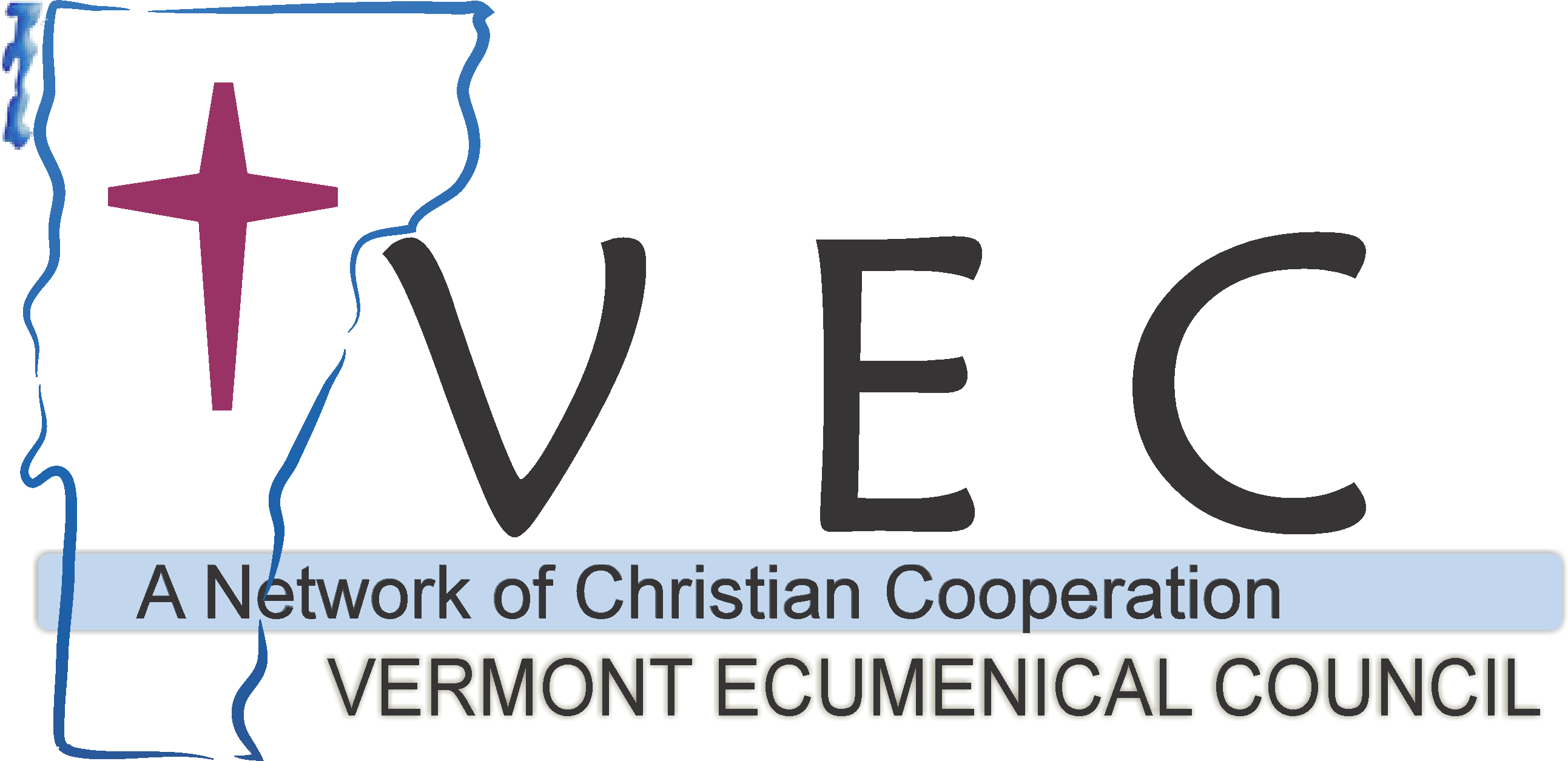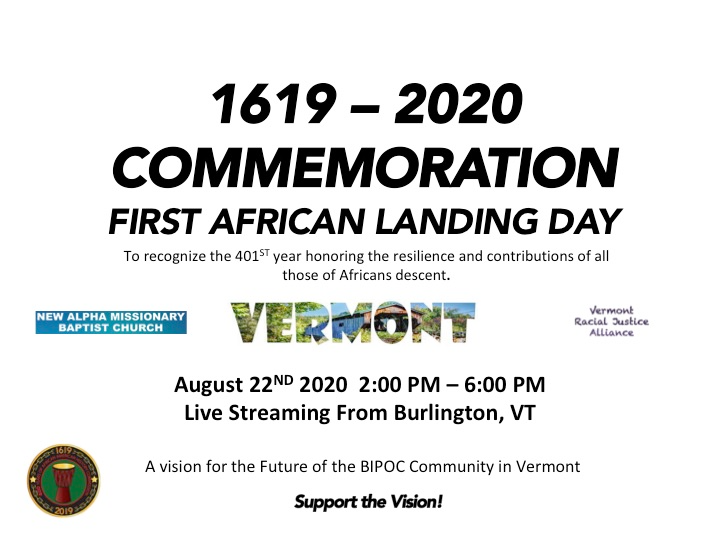
First African Landing Vermont Commemoration
The Vermont Racial Justice Alliance, in partnership with the New Alpha Missionary Baptist Church will be live streaming the second annual FirstAfrican Landing Vermont Commemoration on 22 August 2020, from 2:00 PM till 6:00 PM. Our commemoration culminated last year with Governor Scott proclaiming the 4th Saturday of August First African Landing Day in Vermont! This invitation only, live streaming event will be safety and security monitored for masking and social distancing. All personnel on sight will be required to submit to contact-tracing enabling protocols. You can see the lineup here.
Live Streaming Event: https://www.facebook.com/pg/
This event serves to recognize the 401st anniversary of the landing of the first Africans in English-occupied North America at Point Comfort in1619. Though this second annual African Landing Day Commemoration does not celebrate the circumstances surrounding the arrival of the first Africans to our shores, the commemoration serves as a marker in history that shines a light on the incredibly powerful 401 year journey, and offers some hope in the continued struggle to dismantle the systems of oppression created by the original sin.
We’re excited to be returning to do this event for the second year. All proceeds for the event this year will go to the Building Fund of the New Alpha Missionary Baptist Church, the only church in Vermont that worships in the African American tradition! Our goal of $100K is achievable with your help sponsoring this event. You can choose from three options of sponsorship.
Bronze – For a $1000 sponsoring gift we’ll publicly name your organization as a sponsor.
Silver – Offer a $2500 sponsoring gift and we’ll publicly name your organization as a sponsor and make space for your organization’s banner on the event site.
Gold – With a $5000 sponsoring gift we’ll publicly name your organization as a sponsor, save a seat for you at the event (you’ll be contacted for coordination) and make space for your organization’s banner on the event site.
If you are interested in gifting any other amount or a personal gift, we’ve also created a place for you to give and support this work here. Thank you for partnering with the Vermont Racial Justice Alliance and New Alpha Missionary Baptist Church in this 401-year commemoration of the First African Landing!
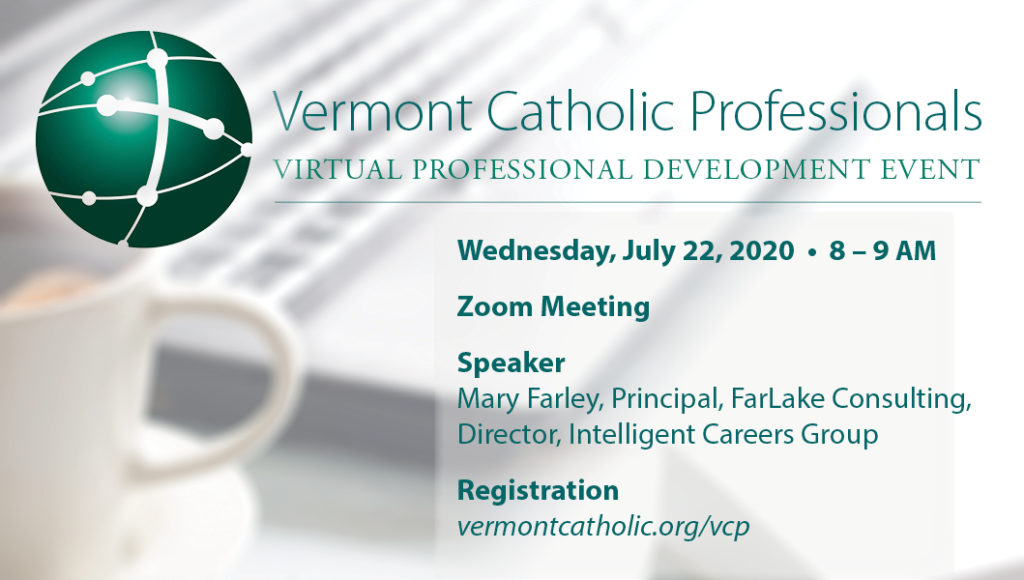
VT Catholic Professionals – Virtual Professional Development Event
Our July guest speaker is Mary Farley — Development Director of North America, Intelligent Careers Group / Founder, FarLake Consulting
Mary will be presenting: “Crossing Communication Barriers By Leading with Love”
Vermont Catholic Professionals was established in 2018 as a networking group to create fellowship of professionals that also share values of the Catholic faith. The purpose of Vermont Catholic Professionals is to join Catholic men and women and others with shared values from the business and professional communities to encourage intellectual discussions, to foster professional and faith-based relationships, and to inspire service and charity to the community in Vermont. Vermont Catholic Professionals will be hosting quarterly networking events which offer networking, refreshments, and a professional development speaker that is relevant to the business and professional communities here in Vermont.
This virtual event is a Zoom meeting. Register here — https://us02web.zoom.us/webinar/register/3415916286903/WN_7YE8H5QMRF-MlHnDNqevjA
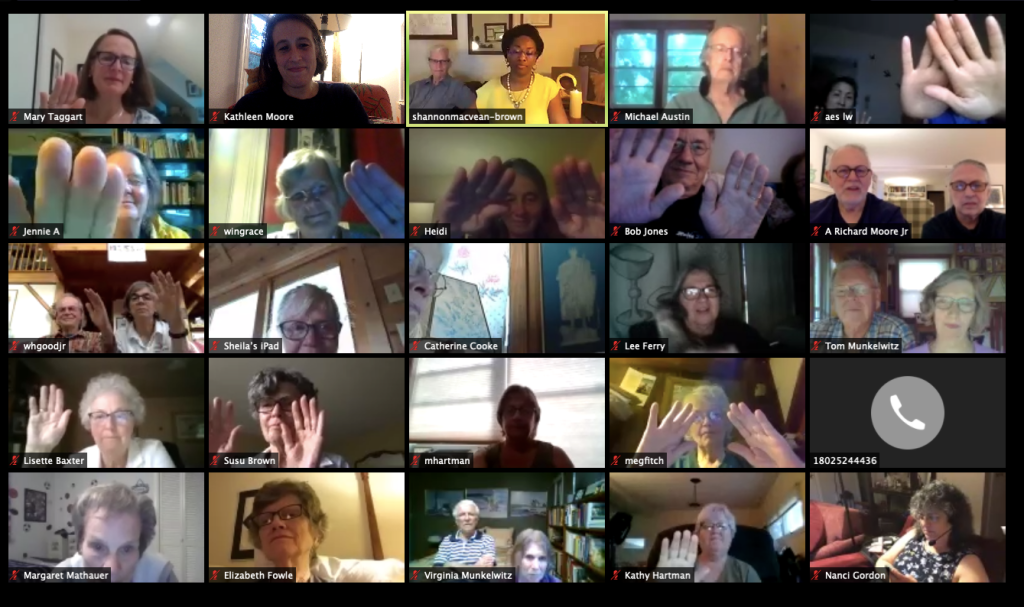
Born in a Pandemic, an Online Congregation Prepares for its Future
On July 7, the 40 or 50 people who had been meeting twice each day for 17 weeks to pray with the bishop of Vermont on Zoom dubbed themselves the Green Mountain Online Abbey, and resolved to carry on without her.
Not that Bishop Shannon MacVean-Brown was going anywhere. Participants would still sometimes see her smiling at them from one of the Hollywood Squares-like boxes on their computer screens from time to time. But she had sensed for several weeks that the online community she had nurtured over the course of the COVID-19 pandemic was ready to continue on its own, and so she relinquished daily liturgical leadership to a newly assembled rota of others.
“I didn’t expect to start a congregation,” Bishop Shannon says. “In an emergency situation you gather and you pray together. I thought well, we can do that. I just wanted to be able to bring people together to remind them—and myself to a certain extent—that we are still the church and we have these things that define who we are, and that can help us remain who we are.
“Within two weeks, though, I thought, ‘This is good. I want to keep this going.’”
Like several dioceses across the Episcopal Church, the Diocese of Vermont began offering online worship on Sundays as the pandemic took hold. This has been especially important in dioceses with small isolated congregations that might not have the resources or broadband access to host worship on their own. Unlike almost any other diocese, after offering her first service on Sunday March 15, the bishop followed up with Morning Prayer at 8 a.m. and Compline at 8 p.m. the following day.
The group hasn’t stopped meeting since. The only deviation in the schedule occurs on Sundays when Morning Prayer with a sermon is held at 11 a.m. As the church’s calendar moved from the middle of Lent to the far side of Pentecost, a community that seldom dips below 40 people coalesced around each service with regular members in Manhattan and New Hampshire and Sunday visitors such as the bishop’s parents in Detroit and a friend of hers in Portugal.
The gathering met a need enhanced by the pandemic, but with deeper roots, participants say. “Everything was falling away, but here was an opportunity to pray, and it just immediately grounded us,” says Wendy Buhner of St. Martin’s Church in Fairlee, who attends services with her husband, Chris, from their farm in Newberry. “Living in Vermont, you often have to drive a great distance to be with people. To be able to turn on your computer and see people and say these prayers, it has been profound. My spirit misses it when I don’t show up.”
The bishop’s decision to use Zoom rather than Facebook Live as the platform for services has proven essential to the community’s development because participants can see one another, interact on occasion, and access the service by telephone, even if they lack cellular service or an internet connection.
“As much as some people pooh-pooh and shy away from Zoom as though it is not good enough, well if that is all we have we have to make it good enough,” Bishop Shannon says. “For us, it has been really life giving because it gives us a chance to pray together and share our concerns with each other.”
Merv Horst, a Mennonite in Manhattan, heard about the service from a friend and found the formality of Episcopal liturgies appealing. The interactions among participants seemed a bit stiff at first, he says, but gradually that began to change.
The Rev. Margaret Mathauer, a vocational deacon at All Saints Church in South Burlington who has led services several times since the bishop stepped away from that role on June 30, says the first signs of connection among members were simple waves, and then brief conversations before and after the service.
“It just sort of happened organically, and I think there is such beauty in that,” says the Rev. Mary Taggart. She has succeeded the Rev. Kathleen Moore, a transitional deacon who recently left the diocese for a call in Erie, Pennsylvania, as the primary organizer of the services. “I am not a big computer person, but you almost forget you are on Zoom when you have been doing it for a long time. It becomes almost second nature.
“My sense is that there are a number of people who live alone, and even though they may be members of a parish that is faithful and checking in with them, they just are craving connection.”
That is true of Mary Gladden, a member of Holy Trinity Church in Swanton, who participates in the services every day by telephone from the Hawk’s Nest Senior Housing in St. Alban’s. “The most basic piece is I can look forward to speaking with somebody twice a day, whether I have guests or not,” she says. “I always feel my church family is my second family, and this has just added to my second family.”
One of the bright spots of her pandemic was the day fellow parishioners Wallace and Natalie Good brought her to their home so she could see the faces of people whose voices had become so familiar to her, she says.
Over time, Bishop Shannon says, it became apparent to participants that worshiping online was not the isolating experience that many Christians feared when the pandemic began. “A church building gives you a sense of intimacy,” she says. “But it is not the same level of intimacy as seeing someone’s bedroom, seeing their pillows behind them. I am pretty sure I have seen people in their pajamas as this thing has gone on. I was surprised by the intimacy that we reached sort of quickly. When somebody was not there, you noticed.”
Mathauer says participants’ trust in one another manifests itself most strikingly in intercessory prayer. “People have some pretty specific things they pray for during the intercessions,” she says. “To the point where sometimes I think, ‘Whoa, I don’t think I’d have the courage to say those kinds of things.’”
In more than four months together, the community has accompanied one member through a spouse’s heart attack, and another through a family member’s mental health crisis. It has prayed with members marooned by the pandemic in distant hotel rooms and prayed with them again when they finally arrived at home.
“Some people have it harder than I do,” Mary Gladden says. “That’s a good, fine thing; to pray for someone else.”
The community has also shared each other’s learning experiences, including Horst’s deepening curiosity about Anglican liturgy and theology and the bishop’s introduction to spring peepers, the small chorus frogs that increasingly supply the background music to compline now that the weather is warmer and participants have taken their computers outside.
Domestic animals have also helped bring the group together. Frequent appearances by Moore’s two cats “gave permission” for other members to introduce their pets, Taggart says. One Sunday Bishop Shannon’s dog, Detroit, spotted a deer in the midst of her sermon with predictably disruptive results. But perhaps no animal earned quite the notoriety as the Buhners’ rooster, Red.
On Father’s Day, Chris Buhner was reading the grave words of the prophet Jeremiah when Red commenced a steady stream of commentary. And though Buhner carried on with a mostly stiff upper lip—”I have become a laughingstock. Everyone mocks me.”—eventually he broke down.
On Wednesday, July 1, someone other than the bishop led a weekday prayer service for the first time since the community first gathered. It was the most visible of several changes.
For the first 17 weeks, the bishop had put together liturgies relying entirely on the Book of Common Prayer, reasoning that it was the book those who could not join the service online were most likely to have in their homes. But as a proponent of expansive language with an interest in other spiritual resources, she was eager to employ other resources including Enriching Our Worship, the New Zealand Prayer Book and St. Helena Breviary. The opportunity arose when Wallace Good offered to provide printed orders of service to attendees who can’t follow the service texts online.
The bishop, who had been consecrated less than six months before the pandemic struck, was also keen to find a way to use Zoom for the parochial visitations that the pandemic kept her from making in person.
Beginning on June 21, she began “visiting” parishes, by asking the host parish to construct the liturgy and provide readers, music and other elements of the service. The bishop still preaches, and the entire diocese is still invited, but the focus is on the host parish.
Most of the Green Mountain Online Abbey plans on remaining through these transitions.
“People talk about getting back to normal,” Wendy Buhner says, “but I feel we have been transported to something different. And how to sustain that … it is part of my spiritual practice.
“I couldn’t have asked for a more profound summer.
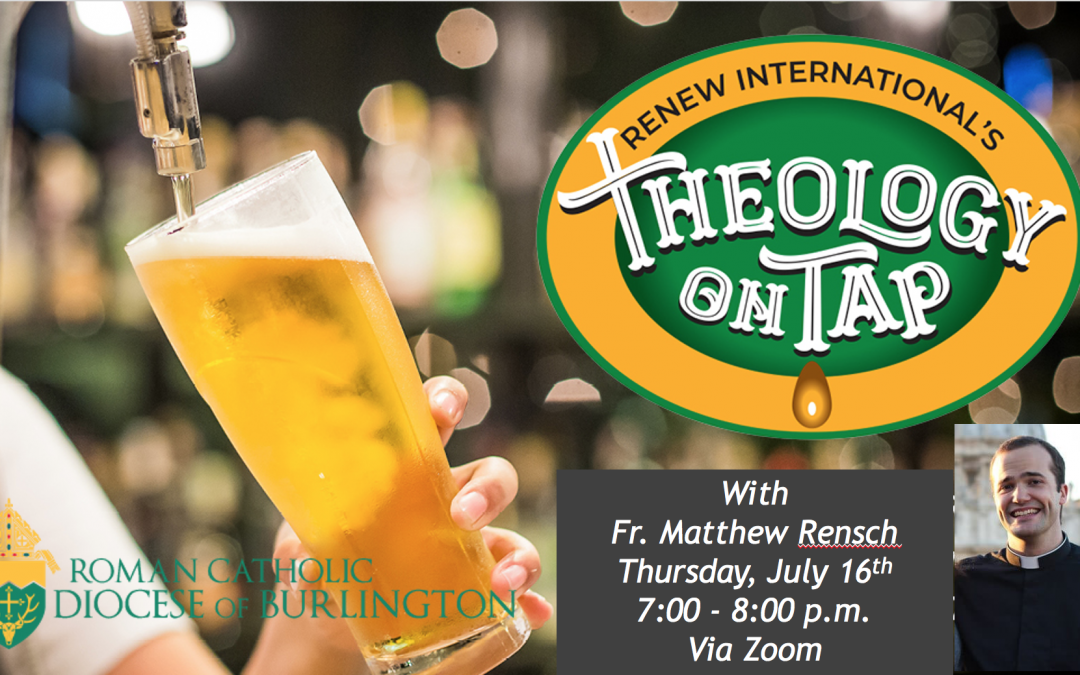
Virtual Theology on Tap with Fr. Matthew Rensch
Theology on Tap is a lecture and discussion series focused on living our Catholic faith. Young adults ages 18-39 are invited to bring their favorite brew and join in!
Register here: https://us02web.zoom.us/meeting/register/tZckdeutqDkpHNOp7d4htweBP2UeIdIJvO83
Date: July 16
- Time:
-
7:00 pm – 8:30 pm
- Event Tags:
- Website:
- https://us02web.zoom.us/meeting/register/tZckdeutqDkpHNOp7d4htweBP2UeIdIJvO83
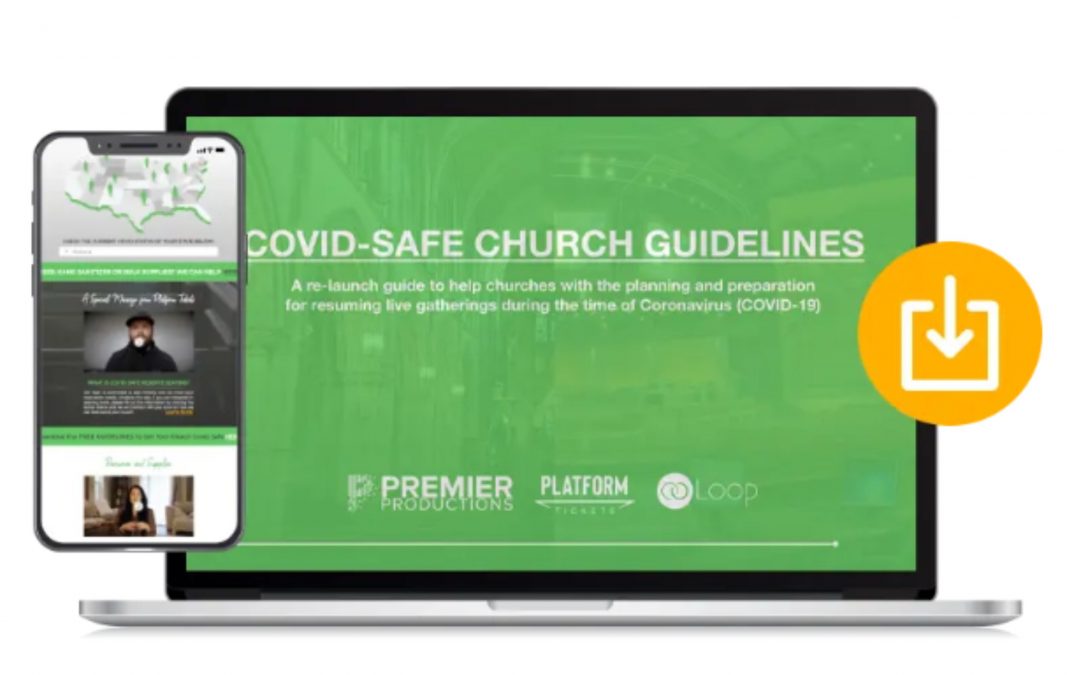
IS YOUR CHURCH COVID-SAFE?
IS YOUR CHURCH COVID-SAFE?
A FREE document designed to help clarify key safety measures and protocols that are important to everyone’s protection, and are in adherence with Centers for Disease Control and Prevention (CDC) guidelines. It is a tool to help you and your leadership team with the planning and preparation needed to be able to offer church and events safely and confidently.
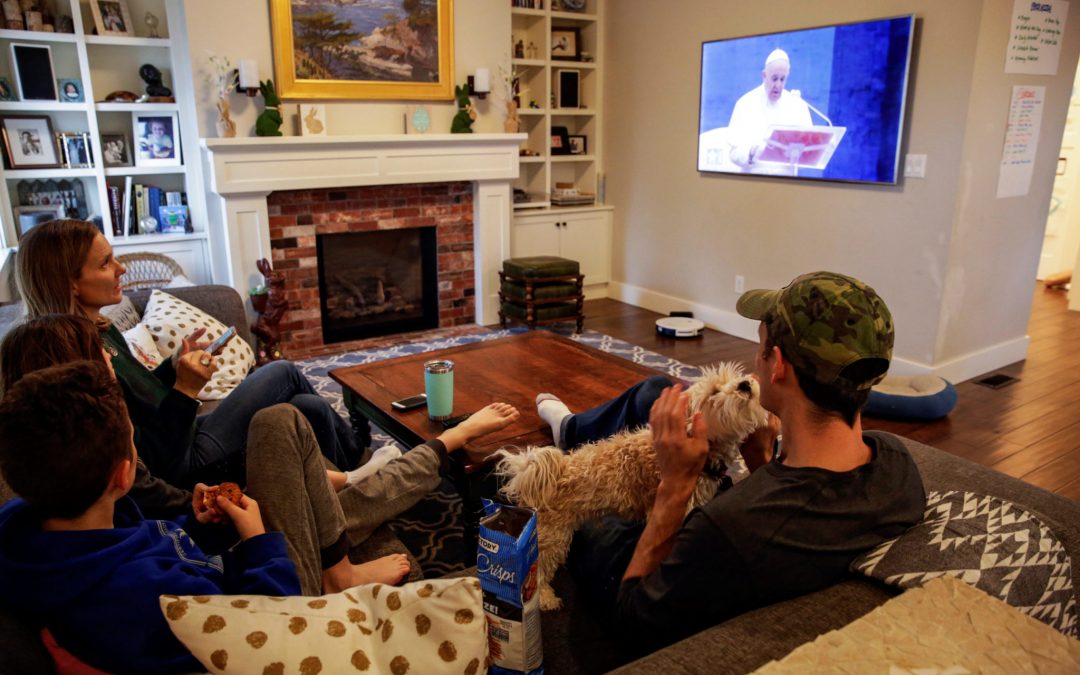
Polls show faith is getting Americans through the coronavirus crisis
Two separate polls show that Americans are relying more on their faith to help persevere through the coronavirus pandemic.
The Pew Research Center, in a survey released April 30, showed that nearly one-fourth of all Americans say their faith has grown stronger during the pandemic, while only 2 percent said it had grown weaker.
Catholics, according to Pew, are very much in line with the overall survey results. Among Catholic respondents, 27 percent said their faith had grown stronger with 2 percent saying it had gotten weaker. In addition, 63 percent said their faith had not changed much at all, and another 7 percent said the question was not applicable because “I am not a religious person and this hasn’t changed.”
A poll by Fordham University released April 28 showed that Americans are being helped by their religious or spiritual faith during the pandemic, and the more often they go to church, the more they feel it has helped.
For those who go to church regularly, 68 percent said they have been “helped a lot,” and another 22 percent said they have been “helped somewhat.” For those who say they go the church frequently, 41 percent said they were helped a lot, with 45 percent reporting they had been helped somewhat. Even a majority of those who say they rarely go to church said faith has helped – 23 percent a lot and 32 percent somewhat.
Among all respondents, 35 percent said they have been helped a lot and 29 percent said they had been helped somewhat, while 34 percent said they had not been helped.
There may be a touch of irony in the polls’ results as significant percentages of Americans are reporting their faith has helped get them through a tough time yet they are unable to attend worship services. The Fordham poll showed 38percent of Americans are attending less frequently, while 56 percent report no change. Just over a quarter are watching services more online or on television now than before the outbreak.
Regular churchgoers reported the largest attendance drop-off, with 67 percent saying they are attending much less often, 4 percent attending somewhat less often and 19 percent reporting no change. To compensate, 55 percent said they are watching online or televised services more than usual.
In the Fordham poll, 62 percent of Catholics said they had been helped at least somewhat by their faith. By comparison, 95 percent of evangelicals reported they had been helped at least somewhat, and just over three-fourths of mainline Protestants reported the same.
Pew’s numbers found that African Americans reported the biggest increase in faith at 41percent, compared to 40 percent for Hispanics and 20 percent for whites. Older Americans likewise found their faith increasing, as nearly 30 percent of all Americans ages 50-up reported increased faith. Women’s numbers were nearly twice as big as men’s, 30 percent compared to 18 percent.
Monika McDermott, Fordham professor of political science, told Catholic News Service that her students in a public opinion and survey research certification program had designed an entirely different poll before the coronavirus started shutting down much of U.S. society. “We met over Zoom and worked remotely” to put together the new survey, she said.
One key finding was in asking who has been guiding respondents personally through the crisis. “Public health officials got the highest rating on that, which is not surprising,” McDermott said. “We also found that state governors were fairly important,” but “not the federal government, and we found that enlightening.”
McDermott added: “We found people are social distancing. We asked about their daily habits. They are avoiding large places so they could be avoiding people who come within six feet.” But one key finding, she noted, was that the “emotional and economic burden is really falling on African Americans from this virus.
She said, we asked them questions such as: Are you still required to go into the workplace, and are you exposed to the virus and do you know people who have died from it? “The numbers are tremendously different if you’re a black American. And those are shocking numbers.”
“There are two completely different communities that are experiencing this in completely different ways,” she said.
Claire Gecewicz, a Pew researcher, said, “It’s a real unique moment in time that we’re in right now. The vast majority of people have lived in a pandemic” — so unique that “this is a question we’ve never asked before.”
Noting some of the demographic differences, Gecewicz said, “What we know from prior research, women tend to be more religious than men. You could make the connection that women are more likely than men to say that their faith has gotten stronger, but our research would suggest, in terms of the racial breakdown, blacks are more likely than white and Hispanics to say their faith has gotten stronger.”
African American survey respondents were the only group that didn’t report at least 90 percent of their churches having closed; their figure was 79 percent. The overall church-closing number was 91 percent, including 95 percent of Catholic churches.
The Pew poll was conducted online with more than 10,000 respondents, and has a margin of error of plus or minus 1.5 percentage points. The Fordham poll, conducted by phone with 1,003 respondents, has a margin of error of 4.3 percentage points.
— Mark Pattison
Photo Credit: CNS/Jason Redmond, Reuters – The McClenahan family of Seattle watch Pope Francis’ special prayer from the Vatican during the “stay home, stay healthy” initiative.
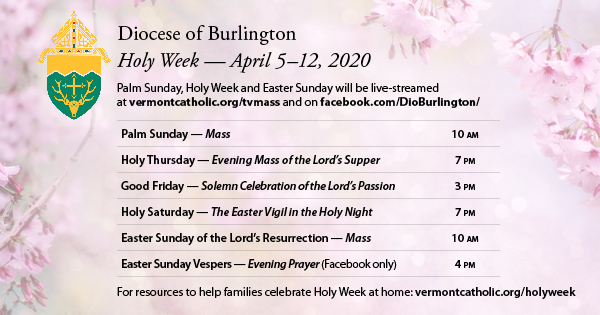
Catholic Holy Week digital celebrations
For Catholics, Holy Week is the culmination of the liturgical year. It contains the three holiest days of the year – the Sacred Triduum – when Catholics celebrate the Lord’s Paschal Mystery – His Passion, Death and Resurrection. Holy Week offers us – through an intense time of prayer and devotion – a way to participate in the Lord’s saving work. The Triduum begins on Thursday with the Evening Mass of the Lord’s Supper and ends on Sunday evening with the celebration of Easter Vespers (Evening Prayer).
“Holy Week is particularly sacred for Catholics, and the closing of all the churches [because of the COVID-19 pandemic] makes it challenging for many of us to celebrate the Sacred Triduum while in isolation,” said Burlington Bishop Christopher Coyne. “That is why my staff and I have created multiple Holy Week engagement opportunities on digital media as a way to unite us all until our doors can open again and we are able to celebrate the Eucharist together with an abundance of gratitude and joy.”
Holy Week Schedule
Most events below will be on diocesan live-stream and can be viewed www.vermontcatholic.org/tvmass and www.facebook.com/DioBurlington
Palm Sunday, 10 a.m. Mass — diocesan live-stream
Holy Thursday, 7 p.m. Mass — diocesan live-stream
Good Friday, 3 p.m. Solemn Celebration of the Lord’s Passion — diocesan live-stream
Easter Vigil (Saturday), 7 p.m. Mass — diocesan live-stream
Easter Sunday, 10 a.m. Mass — Diocesan Live-stream
Easter Sunday Vespers, 4 p.m. Evening Prayer — www.vermontcatholic.org/events and www.facebook.com/DioBurlington
For worship aids and additional resources and activities visit: www.vermontcatholic.org/holyweek
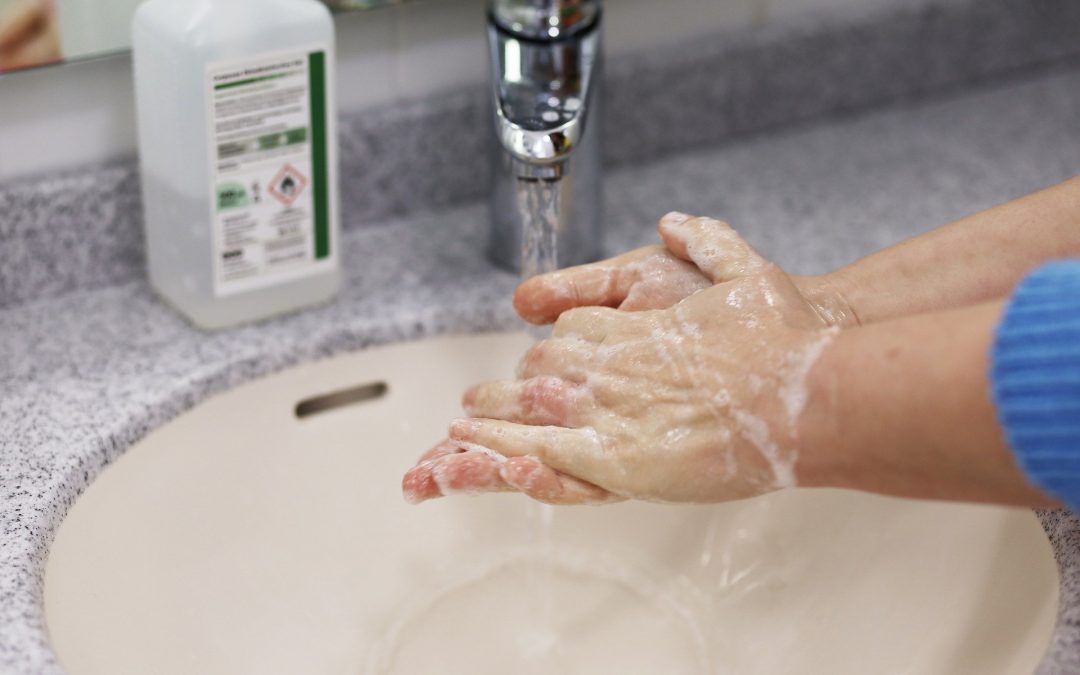
CoronaVirus Hits Home
The CoronaVirus has hit home and many of us are now feeling the effects of closures, rescheduling, delays, postponements, and cancellations. Our new vocabulary word this week is “Social Distancing”, there has been a crazy run on Toilet Paper, store shelves are seen bare, and we now know how long we should be washing our hands… 20 seconds!
With Governor Scott ordering the closures of Vermont Schools, Bishop Christopher Coyne suspending Mass obligations for the near future and many many other churches moving their Sunday services online, we are all left to wonder what will be next.
The Vermont Ecumenical Council: Network of Christian Cooperation has an extensive and comprehensive online calendar of Christian events happening in our state, but we are unable to keep track of all the pending cancellations. So, we ask that you follow up with any event coordinator if you have questions.
And we leave you with a Prayer
Prayer for a Pandemic
May we who are merely inconvenienced
Remember those whose lives are at stake.
May we who have no risk factors
Remember those most vulnerable.
May we who have the luxury of working from home
Remember those who must choose between preserving their health or making their rent.
May we who have the flexibility to care for our children when their schools close
Remember those who have no options.
May we who have to cancel our trips
Remember those who have no safe place to go.
May we who are losing our margin money in the tumult of the economic market
Remember those who have no margin at all.
May we who settle in for a quarantine at home
Remember those who have no home.
As fear grips our country,
Let us choose love.
During this time when we cannot physically wrap our arms around each other,
Let us yet find ways to be the loving embrace of God to our neighbors.
Amen.
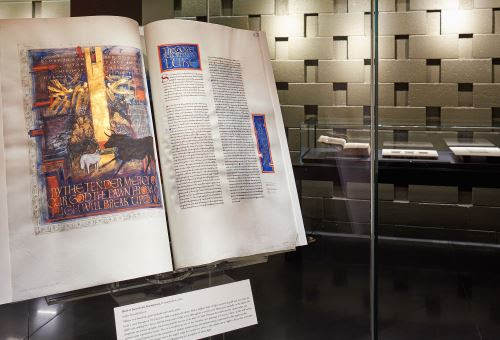
Saint John’s Bible Events
The Saint John’s Bible
In 1998, Saint John’s Abbey and University commissioned renowned calligrapher Donald Jackson to produce a hand-written, hand-illuminated Bible. Excerpts of this bible will be coming to Vermont!
The VECNCC will be hosting several events with presenter Tim Ternes to share this amazing and inspired piece of art, culture and word of God. If you are interested in hosting an event during the week of April 20-24, 2020, please contact us at info@vecncc.org.
We invite you to explore this work of art that unites an ancient Benedictine tradition with the technology and vision of today, illuminating the Word of God for a new millennium. More information available online at http://saintjohnsbible.org

